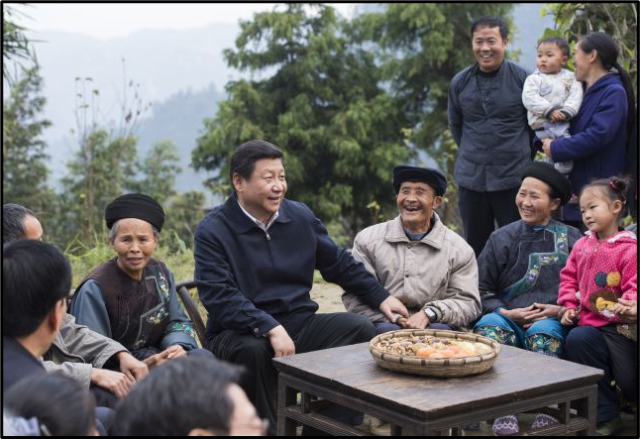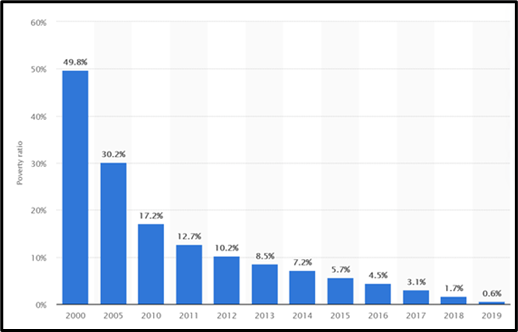
Behind Xi Jinping’s Declaration of Victory Over Poverty
Publication: China Brief Volume: 20 Issue: 22
By:

Introduction
The Chinese state news organization Xinhua announced on November 23 that nine counties in Guizhou had been lifted out of absolute poverty, marking the removal of all counties from China’s national list of most impoverished counties (Xinhua, November 24). About a week later, Chinese Communist Party (CCP) General Secretary Xi Jinping announced that China had achieved the goal of eradicating absolute poverty and becoming a “moderately prosperous society” (小康社会, xiaokang shehui) before the end of 2020 (China Daily, December 2; Xinhua, December 4).[1]
This heralded a wave of triumphal propaganda. Xi stressed the “critical importance of continuously advancing global poverty reduction” during his remarks at the G20 Riyadh Leader’s Summit on November 22, and held up China’s imminent achievement of eliminating absolute poverty ten years ahead of the deadline set by the United Nations 2030 Agenda for Sustainable Development as a model for global emulation (Xinhua, November 23). Chinese official media frequently cited the praise of foreign experts, who were quoted as saying that China’s achievement “gave a hope to the developing countries” and represented a “great historic accomplishment” amid the COVID-19 pandemic (Xinhua, November 25, Xinhua, December 8) On December 14, Xi sent a letter of congratulations to the International Forum on Sharing Poverty Reduction Experience that said, “China stands ready to work with all countries in promoting the process of international poverty reduction and building a community with a shared future for mankind” (China Daily, December 14).
The Strategic Importance of “Poverty Alleviation”
China’s highly publicized victory over absolute poverty serves an important propaganda role that aligns smoothly with efforts to present itself as a responsible, stable and powerful member of the international order. Amid the global chaos of the Covid-19 pandemic, China has sought (not always successfully) to argue that its domestic successes in controlling the pandemic and maintaining economic growth amid a global recession have vindicated its political system as an alternative to Western models for development and governance (Asia Foundation, April 29; China Brief, December 6). More importantly, the project of poverty alleviation is closely tied to the CCP’s legitimacy to rule, and particularly Xi Jinping’s leadership.
The CCP’s revolutionary founding and subsequent leadership of China were predicated on a commitment to social justice (State Council, October 17, 2016). In the 1980s, Deng Xiaoping justified reform and opening up by claiming that “a rising tide lifts all boats”; since 1981, the World Bank estimated that the share of China’s population living under an international poverty line defined as $1.90 (2011 PPP) fell from 88 percent in 1981 to 1.9 percent in 2013, accounting for nearly 70 percent of global extreme poverty reduction in the same timeframe.[2] The greatest reduction in poverty took place in the early 1980s, due in large part to productivity gains from opening up the economy. In the 2000s, poverty reduction continued at a slower pace, but was helped along by the establishment of a variety of poverty alleviation programs, including labor mobility programs for the poor, agricultural production subsidies, investments in rural healthcare and education, rural pension funds, and the national income assistance dibao program that was rolled out in 2007.[3]
In 2012, Xi Jinping set poverty alleviation as one of his key policy focuses after coming to power. While the concept of a “moderately prosperous society” was first proposed by Deng Xiaoping in 1979, the goal of achieving it was set at the November 2012 18th CCP Congress, and subsequently closely connected with Xi Jinping Thought. A binding target to eliminate absolute poverty by the end of 2020 was incorporated into China’s 13th Five Year Plan (FYP)(2016-2020) (State Council, November 23, 2016). The push to eliminate extreme poverty—consisting of the most geographically isolated and difficult to remediate cases left behind by previous poverty alleviation policies—would be accomplished via a new strategy of “targeted poverty alleviation” (also referred to as precision poverty alleviation, 精准扶贫, jingzun fupin), first proposed by Xi in 2013 (China Daily, October 20, 2017). The Chinese economy researcher Terry Sicular explains the uniqueness of the targeted poverty alleviation strategy: whereas previous poverty reduction strategies targeted counties and villages, the new data-driven “targeted/precision” strategy focused on households and individuals. It was also implemented in a “campaign” style that harkened back to the Mao era, involving “a systemwide mobilization of personnel at all levels of government working outside of standard governmental structures” (China Leadership Monitor, December 1).
Poverty alleviation had uneven successes. According to a 2016 “Rural Poverty Monitoring Report” produced by the National Bureau of Statistics (NBS), in 2015 the poverty rate was 1.8 percent in China’s highly developed and largely urbanized eastern provinces; 6.2 percent in central China, and 10 percent in Western China (NBS, 2016). According to official statistics, China’s total urbanization ratio hit 60 percent this past January. But remaining rural residents face poorer healthcare and education systems, as well as more limited public services and social security programs (Xinhua, January 19). Consequently, a “rural revitalization strategy” (乡村振兴战略, xiangcun zhengxin zhanlve), introduced in Xi’s speech to the 19th CCP National Congress and further fleshed out by the promulgation of the “Strategic Plan for Rural Revitalization” (2018-2022), demonstrates the central government’s continued efforts to push for rural urbanization and industrialization as a way of combating poverty (Xinhua, October 18, 2017; Xinhua, September 26, 2018).
It is worth noting that poverty alleviation has been the motivating factor behind state programs to develop China’s interior, resulting in large-scale programs to train and transfer largely ethnic “rural surplus laborer” populations in Tibet and Xinjiang which contribute to the forced Sinicization of oppressed minorities (Journal of Political Risk, December 10, 2019; China Brief, September 22). Rural revitalization has also served as the impetus for controversial village demolition and re-homing programs across China, which have occasionally been a cause for rare discontent (NPR, August 10; Taipei Times, September 8).
Quantifiable targets and practical achievements
The 13th FYP set hard targets for poverty alleviation, marking a historic shift in the Chinese leadership’s approach but also laying the groundwork for carefully defined success. Absolute poverty was defined as living on an annual net income of less than 2,300RMB based on 2010 prices (roughly $340 at current exchange rates) (CGTN, October 17, 2019). This was later updated to an annual income of 4,000RMB (approximately $607) to account for inflation and growing costs of living (Caixin, November 24). Following the implementation of Xi’s “targeted poverty alleviation” strategy, the government identified 832 “poverty-stricken” counties (State Council, December 23, 2014). A national poverty registry (建档立卡) established in 2014 broke poverty in these counties down to the granular level of households and individuals for targeted focus by cadres working on poverty alleviation. In the first year of its implementation, the poverty registry covered 89.6 million individuals nationwide (China Daily, October 20, 2017). Victory was declared after all 832 counties were lifted out of absolute poverty according to official surveys on November 23 (Xinhua, November 24).

Significant effort in terms of personnel and money was invested at the central and local levels to reach this goal. Earmarked fiscal funds for poverty alleviation doubled from 2010-2015 and then nearly tripled over the next three years, reaching 126 billion RMB ($18 billion) in 2019 (People’s Daily, June 3, 2019). In 2016 alone, a reported 775,000 officials were dispatched by the central government to far-flung provinces for poverty alleviation purposes. Many of these cadres were drawn from the CCP Central Committee’s Organization Department, indicating the political importance of their work ((ISDP, March 2019).
At the same time, Sicular observes that the goal of “eliminating absolute poverty” was pragmatically defined to allow its achievement. It targeted only rural poverty and defined absolute poverty by a relatively low standard; for comparison, China’s 2,300RMB per year benchmark is slightly higher than the World Bank’s definition of $1.90 a day, which is generally used in reference to the world’s poorest countries (China Leadership Monitor, December 1; PovcalNet, undated). Poverty in lower-middle and upper-income countries is usually tracked using benchmarks of $3.20 and $5.50 a day, respectively. If the $5.50 per day benchmark is applied to China, technically an upper-middle income country, its poverty rate in 2018 rises from 1.7 percent to 17 percent of the country’s total population (CSIS, December 8).
China’s rapid growth since the 1980s lifted national living standards, but also coincided with an unprecedented widening of the wealth gap between rich and poor. By framing the poverty eradication goal in terms of absolute rather than relative poverty, the Chinese government’s messaging on poverty alleviation sidestepped thorny problems related to inequality. Many of these issues have been exacerbated by the COVID-19 pandemic. China’s richest billionaires gained extraordinary wealth this year, and the annual Hurun List reported in October that an additional 257 Chinese billionaires were created during the course of the pandemic (China Daily, May 28; Quartz, October 20). At the other end of the spectrum, rural migrant workers, who are estimated to comprise more than a third of China’s entire working population, were systematically undercounted in official unemployment numbers but likely suffered especial hardships amid widespread lockdowns and labor shocks during the first half of the year (China Labor Bulletin, May 11; SCMP, November 17).
Premier Li Keqiang raised this problem succinctly during a work conference focusing on China’s economic recovery from COVID-19 in May when he noted that 600 million of China’s 1.4 billion population earned an average monthly income of 1,000 RMB (about $140) or less and were at severe risk for sinking further into poverty following the pandemic (China News Network, May 29). Unlike other countries, China’s economic response to the pandemic did not include direct fiscal stimulus, but instead focused on monetary easing policies meant to drive supply. In November, China’s consumption lagged behind recovery in other sectors such as investment, industrial production and exports, sparking worries that individual households were recovering slower than the overall economy (Caixin, December 15).
Conclusion
How then to read the December declaration of victory over poverty alleviation amid China’s ongoing economic recovery? Foreign observers have noted that it’s important not to discount the real impact of China’s poverty alleviation efforts: Matthew Chitwood, a writer and poverty researcher, says, “We should not forget the big picture that this represents improved livelihoods for almost 100 million people over the last eight years” (SupChina, November 24). Terry Sicular notes that while the state’s achievement of its goal to “eradicate absolute poverty” marks the achievement of a plan that was simultaneously ambitious and limited in scope, the state’s subsequent efforts to combat poverty will have to address ongoing systemic issues such as wealth inequality and the rural-urban divide that may ultimately prove harder to resolve (China Leadership Monitor, December 1). Li Xiaoyun, a poverty relief expert at the China Agricultural University in Beijing, has warned that China’s fight against poverty must now shift to waging a “protracted war” against relative poverty (Caixin, November 24). In other words, after Xi’s December victory announcement, the toughest battles of China’s poverty alleviation remain unwon.
Notes
[1] Achieving a “moderately prosperous society” by the centenary of the founding of the CCP is one of the Two Centenaries (两个一百年, liangge yibainian), first set forth at the 18th National Congress of the CCP held in 2012. The other “centenary” refers to the achievement of becoming a “a prosperous, strong, democratic, culturally advanced, harmonious modern socialist country” (富强民主文明和谐的社会主义现代化国家, fu qiang minzu wenhua hexie de shehui zhuyi xiandaihua guojia )by the centenary of the founding of the PRC in 2049 (People’s Daily, January 18, 2016).
[2] See: “China Systematic Country Diagnostic: Towards a More Inclusive and Sustainable Development,” World Bank, 2017, https://documents1.worldbank.org/curated/en/147231519162198351/pdf/China-SCD-publishing-version-final-for-submission-02142018.pdf.
[3] Ibid. See also: Katherine Musgrave, “Updates on SDG [Sustainable Development Goals] 10 in China,” The Borgen Project, September 24, 2020, https://borgenproject.org/sdg-10-in-china/.
Elizabeth Chen is the editor of China Brief. For any comments, queries, or submissions, feel free to reach out to her at: cbeditor@jamestown.org.




